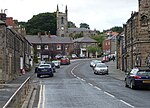Eglingham is a village in Northumberland, England, situated about 7 miles (11 km) north-west of Alnwick and 10 miles (16 km) from Wooler. It lies in the sheltered valley of the Eglingham Burn, a tributary of the River Aln, about 100 metres (330 ft) above sea level, in a rural conservation area set amongst rolling countryside, within 5 miles (8 km) of the Cheviot Hills. The village is surrounded by mainly arable farmland, moorland and woodland, including an arboretum and some commercial forestry.
The village has about 60 dwellings and a population of about 100, most situated either side of the through-road, and including the local manorial property, Eglingham Hall.
Eglingham is also a parish, about nine miles (14 km) in length by four and a half in breadth, with an area of 23,361 acres (94.54 km2). It comprises 2 villages: South Charlton and Eglingham; and 4 settlements – Bassington, Ditchburn, Harehope, Shipley – and several smaller places. The River Breamish, which rises in the Cheviots, runs through the parish. The geological composition of the parish includes rich gravelly loam along the path of the river; clay predominating in the centre of the parish, and unenclosed moorland in the south and east. Within the moor area is Kimmer Loch, covering 10 acres (4.0 ha), and reputed to abound in perch and pike.
The parish is largely agricultural, although gravel extraction continues to the west. Villages in the parish also serve as bases for commuters working in Alnwick and Newcastle upon Tyne.






